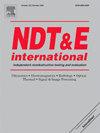用巴克豪森噪声和先进显微技术研究有磨削烧伤的轴承钢。碳化物稳定性在钢性能中的作用
IF 4.1
2区 材料科学
Q1 MATERIALS SCIENCE, CHARACTERIZATION & TESTING
引用次数: 0
摘要
磁巴克豪森噪声(MBN)信号对试样的微观结构和应力非常敏感。然而,微观结构与MBN信号之间的联系的许多细节仍有待了解。在这里,先进的显微镜技术和x射线衍射方法被用于工业相关钢结构的表征,结果与MBN信号结果相关联。本文研究了具有不同碳化物结构的两种不同的滚动轴承钢,即渗碳钢(CC)和100Cr6轴承钢在磨削循环中的热烧伤。用不同的表征和可视化方法分析了钢的热稳定性,以联系影响观察到的磁巴克豪森噪声信号变化的结构特征。由于所研究的钢的不同制造操作和成分,除了它们对热烧伤的不同MBN行为外,还观察到碳化物结构和产生的磁畴结构的变化。研究发现,100Cr6轴承钢中较大且稳定的碳化物具有较好的热负荷承受能力,而表面渗碳钢的显微组织和MBN变化更大。这项工作探讨了结构对碳化物稳定性的作用,并讨论了巴克豪森噪声信号与关键因素(如位错密度、残余奥氏体分数、残余应力状态、畴壁厚度,特别是碳化物尺寸)之间的相关性。本文章由计算机程序翻译,如有差异,请以英文原文为准。

Bearing steels with grinding burns studied by Barkhausen noise and advanced microscopy techniques – Role of carbides stability in steel performance
Magnetic Barkhausen noise (MBN) signal is very sensitive to microstructure and stresses of the sample. However, many details of the link between microstructure and MBN signal still remain to be understood. Here, advanced microscopy techniques together with X-ray diffraction method were used for characterization of the industrially-relevant steel structures and the results were linked to the MBN signal outcomes. This study deals with thermal burn during grinding cycles of two different roll-bearing steels, case-carburised (CC) steel and 100Cr6 bearing steel, with different carbide structures. Thermal stability of steels is analysed with many different characterization and visualisation methods to link the structural features affecting the observed magnetic Barkhausen noise signal changes. Due to the different manufacturing operations and compositions of the studied steels, the carbide structure and produced magnetic domain structure, were observed to vary in addition to their different MBN behaviour against thermal burn. Larger and more stable carbides in 100Cr6 bearing steel were noticed to tolerate better the thermal load whereas case-carburised steel underwent more changes in the microstructure and also in the MBN. The work explores the role of structure on carbide stability and discusses the correlation between Barkhausen noise signals and key factors, such as dislocation density, retained austenite fraction, residual stress state, domain wall thickness, and particularly carbide size.
求助全文
通过发布文献求助,成功后即可免费获取论文全文。
去求助
来源期刊

Ndt & E International
工程技术-材料科学:表征与测试
CiteScore
7.20
自引率
9.50%
发文量
121
审稿时长
55 days
期刊介绍:
NDT&E international publishes peer-reviewed results of original research and development in all categories of the fields of nondestructive testing and evaluation including ultrasonics, electromagnetics, radiography, optical and thermal methods. In addition to traditional NDE topics, the emerging technology area of inspection of civil structures and materials is also emphasized. The journal publishes original papers on research and development of new inspection techniques and methods, as well as on novel and innovative applications of established methods. Papers on NDE sensors and their applications both for inspection and process control, as well as papers describing novel NDE systems for structural health monitoring and their performance in industrial settings are also considered. Other regular features include international news, new equipment and a calendar of forthcoming worldwide meetings. This journal is listed in Current Contents.
 求助内容:
求助内容: 应助结果提醒方式:
应助结果提醒方式:


